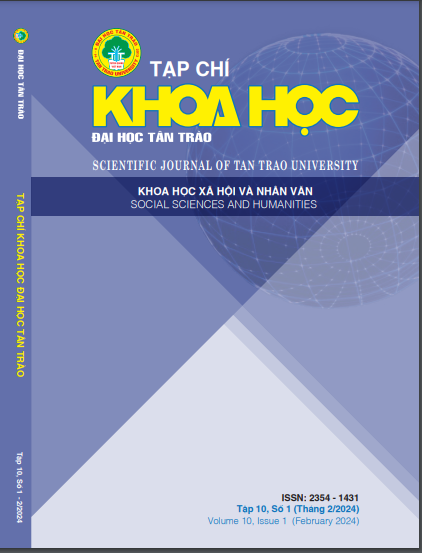INDIGENOUS FAITHS AND THANISM WORSHIP BELIEFS IN VIETNAMESE CULTURE
DOI:
https://doi.org/10.51453/2354-1431/2024/1089Keywords:
indigenous faiths; Thanism Worship beliefs; integration; nation’s core values; quintessenceAbstract
In recent years, the policy of preserving and developing religions and beliefs has been increasingly focused on promoting the quintessence of the Vietnamese peoples. As classified to the only country with indigenous religious characteristics, which reflects the knowledge, beliefs, and way of life of its people that is preserved and promoted from one generation to another with the cultural and spiritual diversity in society. The process of integrating with domestic and foreign cultures has formed cross-cultures, which characterizes the process of interaction and exchange between different cultures, leading to mixing and creating cultural diversity. These dynamic activities create opportunities for development and progress, while simultaneously fading indigenous religions, which requires cultural managers to make appropriate adjustments to preserve the nation's core values and integrate new cultures to create a diverse and rich environment, contributing to the comprehensive development of the community.
Downloads
References
Alex, Detailed Maps Of The World’s Religions. (2015). https://vividmaps.com/maps-of- worlds-religions/, June 9th, 2015
Ho Chi Minh. (1997). On Culture, Ho Chi Minh Museum, Hanoi, 1997.
Kroeber, A. L., & Kluckhohn, C. (1952). Culture: a critical review of concepts and definitions. Papers. Peabody Museum of Archaeology & Ethnology, Harvard University, 47(1), viii, 223.
Li & Karakowsky. (2001). Do We See Eye-to- Eye? Implications of Cultural Differences for Cross-Cultural Management Research and Practice. The Journal of Psychology, 135(5), 501-517
Ly Hieu Tung. (2021). Some proposals for cultural zoning in sustainable regional development in Vietnam, Journal of Ethnic Studies, vol. 10, no. 2, pp. 96-103, 2021.
Ngo Duc Thinh. (2022). Regional culture and cultural zoning in Vietnam. National Culture Publishing House, 2022.
Nguyen Thanh Tuan (2007). Current policy on managing cultural regions in Vietnam, Communist Magazine, March 3rd, 2007. https://tapchicongsan.org.vn/tin-tieu- diem-10-06/-/2018/394/chinh-sach-quan- ly-cac-vung-van-hoa-o-viet-nam-hien-nay. aspx#:~:text=Thus%20there%20will%20 be%20widely%20accepted.
Tran Ngoc Them (1997). Searching for Vietnamese cultural identity. Ho Chi Minh City Publishing House, p. 27, 1997.
Tran Quoc Vuong. (2004). Vietnamese cultural foundations. Education Publishing House, Hanoi, p. 17, 2004.
UNESCO “International Round Table “Intangible Cultural Heritage” - Working definitions” (Piedmont, Italy, 14 to 17 March 2001). https://ich.unesco.org/doc/src/05297- EN.pdf
Downloads
Published
How to Cite
Issue
Section
License

This work is licensed under a Creative Commons Attribution-ShareAlike 4.0 International License.
All articles published in SJTTU are licensed under a Creative Commons Attribution-ShareAlike 4.0 International (CC BY-SA) license. This means anyone is free to copy, transform, or redistribute articles for any lawful purpose in any medium, provided they give appropriate attribution to the original author(s) and SJTTU, link to the license, indicate if changes were made, and redistribute any derivative work under the same license.
Copyright on articles is retained by the respective author(s), without restrictions. A non-exclusive license is granted to SJTTU to publish the article and identify itself as its original publisher, along with the commercial right to include the article in a hardcopy issue for sale to libraries and individuals.
Although the conditions of the CC BY-SA license don't apply to authors (as the copyright holder of your article, you have no restrictions on your rights), by submitting to SJTTU, authors recognize the rights of readers, and must grant any third party the right to use their article to the extent provided by the license.


